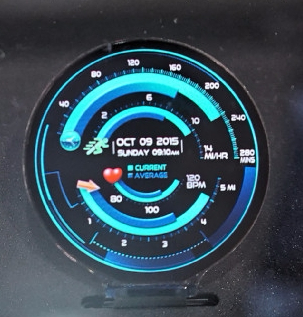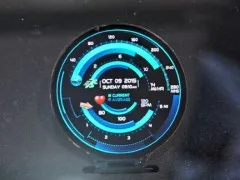AUO started by showing us its 1.3″ (320 x 320 – 257ppi 350 cd/m²) plastic AMOLED and its 1.4″ “Full Circle” (400 x 400 – 287ppi 350 cd/m²) OLED which won the SID Best in Show award for 2015. The display uses special driver and cutting techniques to form a completely round display.

Next we looked at “the world’s thinnest LCD” which was a 4.3″ FullHD device with 512ppi and 700 cd/m² of brightness and is just 0.915mm thick and uses 0.1mm thick glass. This was a technology demo, but AUO could go to mass production if there is interest from phone makers.
Another tech demo was a 3.5″ 320 x 480 AHVA plastic LCD that is conformable and is made using a glass carrier. The TFT process operates at 220ºC and uses a substrate of just 0.06mm. Brightness was 380cd/m² and contrast 1000:1. The bending radius was 44mm and the panel thickness <0.26mm excluding the BLU.
For automotive there were 8″/9″ and 10.1″ AHVA displays for centre consoles. These have 3,000:1 contrast and are direct bonded which allows very precise control of the light output. The light from the display is emitted in a tight cone to minimise light spill, especially at night.
AUO is developing transflective displays, but no details were available of performance, although the reduced gamut was apparent.
Turning to notebook applications, there were 15.6″ and 17.3″ UltraHD panels, the former using an oxide backplane with UV alignment, while the larger one used an a-Si backplane and UV alignment techniques.
A 10.1″ touch panel with 1024 x 600 resolution, 250cd/m² of brightness and based on TN technology was using OGS procap touch and air bonding. “More than” 10 point touch is supported. A 24″ panel also has this feature and uses toughened glass that is said to be able to survive the drop of a 0.54kg steel ball from 1.3M.
Finally, we looked at a 2.6″ transflective display that uses ECB mode and features 160 x 240 resolution, 8% reflectance and 26:1 contrast ratio. Gamut looked limited, but a number was not stated. There was also a 1.3″ transflective display that uses “memory in pixel” technology that uses <0.25mW – just 1.7% of the conventional equivalent when the backlight is off.

